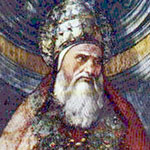
Pope Pius I was the 10th pope of the Church and led from around 140 to 155 AD. He was known for his views on Easter and for his family, which included a wealthy freedman, Hermas who was his brother. This article will cover the early life of Pius and his later years that led to him becoming Pope Saint Pius.
Early Life
Pius was Italian by birth as his father was also Italian. Born sometime in the latter part of the first century, he was born and raised in the small town of Aquileia.
An early book written about popes claimed that his father was a man named Rufinus and that he had a brother named Hermas.
Another book about popes claimed that both men were former slaves and later freedmen.
Papacy
Following the martyrdom of Pope Saint Hyginus, the Church looked for someone new to lead them. The bishops chose Pius and asked him to assume the role circa 140 AD. During his papacy, he did two important things.
The first was an official decree that stated people should only celebrate Easter on Sundays as this was the Holy Day. He decided that Christians should celebrate Easter on the first Sunday that came after the first full moon in March.
Pope Pius would also have a hand in the construction of Santa Pudenziana, which is one of the oldest churches in Italy. In keeping with the tradition at the time, he used his birth name as his papal name.
Eleven other popes and one antipope would use the same name. The last pope named Pius was Pope Pius XII who ruled from 1939 to 1958.
Saint Justin
Pope Pius was in Rome when Saint Justin arrived to teach. Also known as Justin Martyr, he taught theology and left behind several writings, including The First Apology and Dialogue with Trypho. Justin would also write about some of the apostles and others who were martyrs.
Known for his attempts to teach the heretics in Rome, he would become a martyr when he refused to stop teaching. Some historians doubt that Pope Pius was a martyr or that he ruled during the listed dates as Saint Justin was there at the same time and did not mention him.
Later Years
To help the Church, Pope Pius spoke out against its opponents and publicly denied that the Gnostics and Valentinians were correct in their beliefs. An early book called Roman Breviary contained the Latin rites of the Church and standards the popes needed to follow.
This was one of the first books to mention that Pope Pius was martyred. When revising the General Roman Calendar in the 21st century, workers could find no proof of his martyrdom.
The Roman Missal includes his name and set his feast date as a memorial in which followers could remember his papacy. This new ruling also states that those who live in locations where other celebrations occur on that date do not need to recognize him on his feast date.
Quick Facts About Pope Pius I
- Pius was born in Aquileia, which was a small town in southern Italy.
- He was born in the late part of the first century.
- The pope died circa 155 AD.
- Tradition holds that he was a martyr and died by beheading.
- His papacy began circa 140 AD.
- The papacy of Pope Pius I ended circa 155 AD.
- His successor was Pope Anicetus who also died as a martyr.
Interesting Facts About Pope Pius I
- Though some reports indicate that the pope and his brother were slaves, there is some belief that Herma used the term slave to show that he was from a lower class or working-class family. Later reports would assume that he meant they belonged to someone else and were given their freedom.
- To show that he was a martyr, most of the illustrations of Pope Pius show him with a halo that wraps around his head. Artists also drew him with a sad look in his eyes and a short beard.
- Pius was only the ninth man to serve the Church after Pope Saint Peter. Church records indicate that he ruled as pope for more than 15 years, which was longer than any of his predecessors.
- His brother wrote The Shepherd of Hermas, which was an early Christian book that discussed the sins of others and what would happen to those who sinned.
- Within the Christian Church, Pope Pius is a canonized saint. The Church celebrates the feast day of Pope Saint Pius on July 11.